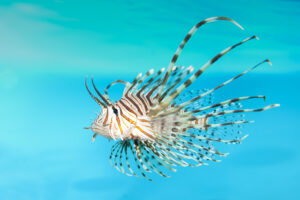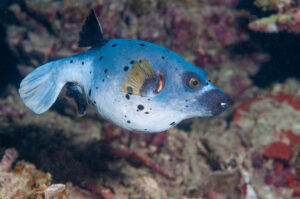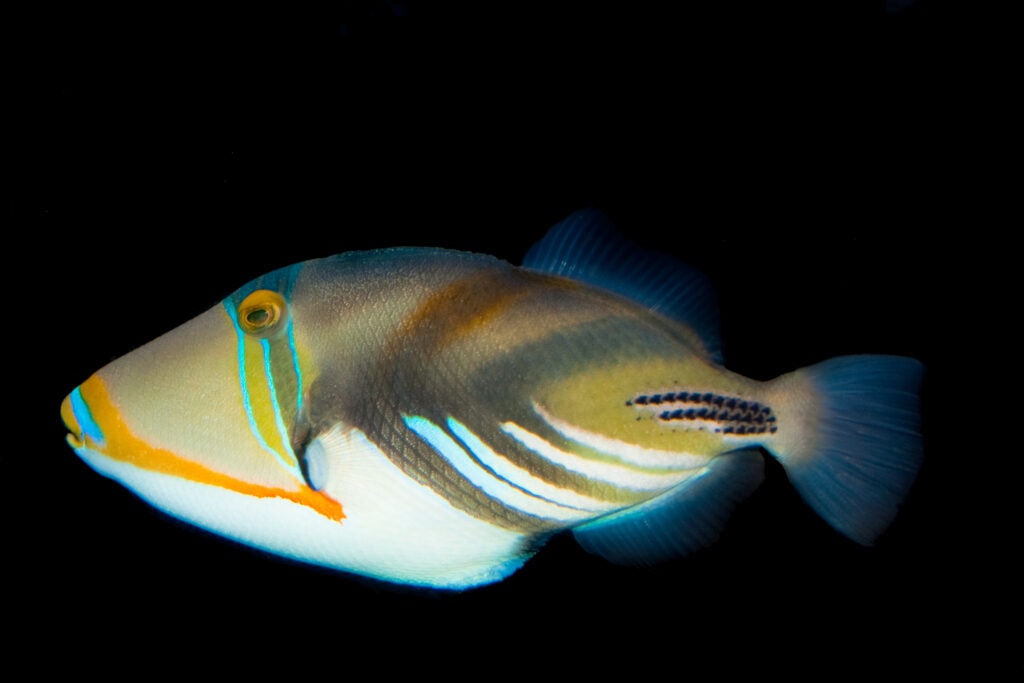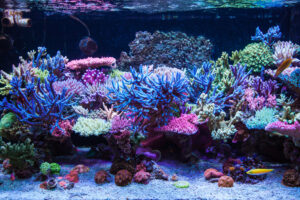Just like on the freshwater side, which has its big arowanas, catfish, pacus, etc., there is a niche for “monster” fishkeeping amongst marine aquarists. If you have a massive tank and don’t plan on keeping a conventional reef system, these fish might be perfect for you. Indeed, there are many people in this hobby that prefer fish (especially big fish) over coral and do not at all object to maintaining a fish-only system. While technically not reef tanks, some of these aquaria do contain large amounts of live rock. In fact, there is actually a special name for these saltwater aquariums: FOWLR tanks. FOWLR stands for “fish only with live rock.”
These aquaria usually consist of fish that are larger or are deemed as not reef-safe. We here provide just a few examples of some great FOWLR fish species!
Volitan lionfish
 The volitan lionfish is the most notorious large fish in this hobby for many reasons (for example, it has become invasive in some U.S. waters). They are extremely hardy and undemanding. Most of the time, lionfish will start off only eating live food but can eventually be trained to eat frozen food and sometimes even pellets. They are very opportunistic and if they think something can fit in their mouth, they will eat it. That’s why it is important to ensure that anything you add to your tank with a lionfish is significantly larger than the mouth of the lionfish.
The volitan lionfish is the most notorious large fish in this hobby for many reasons (for example, it has become invasive in some U.S. waters). They are extremely hardy and undemanding. Most of the time, lionfish will start off only eating live food but can eventually be trained to eat frozen food and sometimes even pellets. They are very opportunistic and if they think something can fit in their mouth, they will eat it. That’s why it is important to ensure that anything you add to your tank with a lionfish is significantly larger than the mouth of the lionfish.
Lionfish are venomous. Each long spike on their body has venom on the inside of it and if it punctures you, can cause extreme pain. This is what they use to defend themselves; however, it is rare for them to puncture any of the fish in an aquarium. Most fish see their spines and will steer clear so it prevents any issues from occurring. It is important to keep an eye out for your lionfish when completing any tank maintenance as they are very curious and will follow you around when you’re cleaning the tank.
Volitan lionfish can easily reach up to 12 inches in length. They require minimum tank size of 150 gallons.
Humu humu triggerfish
The Humu humu trigger is also commonly called the Picasso trigger. With its remarkably beautiful patterns (which is why it is named after the famous Spanish painter), it is a stunning addition to any FOWLR tank. Picasso triggers thrive on a carnivore diet and are easily trained to accept flakes and pellets. Because they have a strong feeding response, it is important to be careful when placing your hands in the aquarium as they may mistake your hand for food. It is best to keep these triggers with fish that are larger in size to prevent them from being pestered or eaten. Once humu triggers grow familiar with who is feeding them, it is very common for them to have almost dog-like personalities and will be very interactive with their owner.
They have large teeth that help them grind up mollusks, crustaceans, etc. in the wild so offering them frozen clams will be appreciated. Their teeth continue to grow and can actually overgrow if they aren’t offered anything to file them down with. It isn’t uncommon to just see them chewing on your live rock for their teeth and that is just one reason why these fish are not reef safe (they can also chew on the coral and eat invertebrates).
These aggressive predators can reach up to 10 inches and it is recommended to have a minimum of a 75 gallon aquarium for them.
Dogface pufferfish
 The dogface puffer has one of the brightest personalities that you will see in any saltwater fish. They are very interactive and can be quite entertaining to watch. Once they get comfortable in your aquarium, they will quickly become the star of the tank. They thrive on a carnivore diet. It is best to occasionally feed them clams to allow them to file their teeth down. They may be trained on flakes and pellets and it is better to give them a varied diet. They are not reef-safe and are known for picking at corals and invertebrates. Thus, it best to avoid keeping any of those animals in a tank with this puffer.
The dogface puffer has one of the brightest personalities that you will see in any saltwater fish. They are very interactive and can be quite entertaining to watch. Once they get comfortable in your aquarium, they will quickly become the star of the tank. They thrive on a carnivore diet. It is best to occasionally feed them clams to allow them to file their teeth down. They may be trained on flakes and pellets and it is better to give them a varied diet. They are not reef-safe and are known for picking at corals and invertebrates. Thus, it best to avoid keeping any of those animals in a tank with this puffer.
You may occasionally see your dogface puffer puffed up; this does not always mean that they are stressed out. Sometimes they need to stretch and work out the muscles that allow them to puff so if you haven’t noticed anything causing stress to your puffer but it is still puffed out, it may just be stretching. Now, if your puffer appears to be puffed out often, you may need to assess what is going on in your tank. Always ensure that everything stocked in your tank is suitable with a dogface puffer. Sometimes, they puff up when they feel threatened by another fish in the aquarium. If you notice a fish picking on your puffer, it may be best to reevaluate what is stocked in your tank and make some adjustments. They become very stressed out when they puff for defense and is not great for their health. If your puffer continues to be stressed and puffing constantly, it may not live long!
Dogface puffers are very hardy fish but they can be sensitive in temperament. If there’s something in the tank that they don’t like, they will easily become stressed out and will become very shy and hide most of the time. If you have predatory fish with your puffer it is better to purchase it at a fairly large size or at least the same size as the other fish to prevent it from being picked on and stressed out.
These puffers can reach 12 inches in length. They require lots of swim space as they spend their days exploring all over the aquarium. They are therefore best kept in a tank of at least 150 gallons.






Leave a Reply